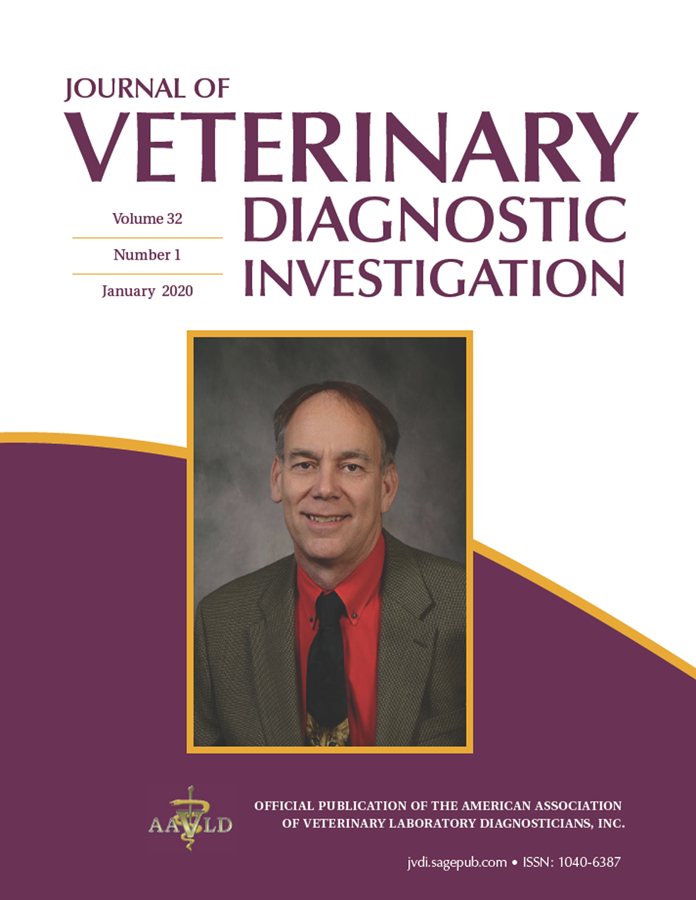Ver ítem
- xmlui.general.dspace_homeCentros Regionales y EEAsCentro Regional Santa FeEEA RafaelaArtículos científicosxmlui.ArtifactBrowser.ItemViewer.trail
- Inicio
- Centros Regionales y EEAs
- Centro Regional Santa Fe
- EEA Rafaela
- Artículos científicos
- Ver ítem
Development and evaluation of a double-antigen sandwich ELISA to identify Anaplasma marginale–infected and A. centrale–vaccinated cattle
Resumen
Bovine anaplasmosis is a worldwide infectious disease caused by the intraerythrocytic bacterium Anaplasma
marginale, which is transmitted by ticks and fomites. A. centrale is a less virulent subspecies used as a live vaccine in
cohorts of 8- to 10-mo-old calves that did not naturally reach enzootic stability. We developed 3 variants of a double-antigen
sandwich ELISA (dasELISA) using a recombinant major surface protein 5 (MSP5) from A. marginale
[ver mas...]
Bovine anaplasmosis is a worldwide infectious disease caused by the intraerythrocytic bacterium Anaplasma
marginale, which is transmitted by ticks and fomites. A. centrale is a less virulent subspecies used as a live vaccine in
cohorts of 8- to 10-mo-old calves that did not naturally reach enzootic stability. We developed 3 variants of a double-antigen
sandwich ELISA (dasELISA) using a recombinant major surface protein 5 (MSP5) from A. marginale (dasELISAm) or
from A. centrale (dasELISAc) or using MSP5 from both organisms (dasELISAmc). Each dasELISA was tested for the
detection of antibodies against A. marginale and A. centrale. The tests were validated using serum samples from cattle not
infected with Anaplasma spp. (n = 388), infected with A. marginale (n = 436), and vaccinated with A. centrale (n = 358),
confirmed by nested PCR. A total of 462 samples were compared with a commercial competitive ELISA (cELISA). For
dasELISAm, dasELISAc, and dasELISAmc, specificities were 98.7%, 98.7%, and 97.4%, and overall sensitivities were
92.6%, 85.7%, and 97.4%, respectively. For A. marginale–infected and A. centrale–vaccinated cattle, sensitivities were
97.7% and 86.3% for dasELISAm, and 77.7% and 95.5% for dasELISAc, respectively. Sensitivity of dasELISAmc was
similar for both groups (>96%). The agreement rate between dasELISAmc and cELISA was 96.3% (κ = 0.92); the former
test allowed earlier detection of seroconversion of vaccinated cattle than did cELISA. Based on these results, the test could
be used to 1) determine the enzootic stability or instability of anaplasmosis in calves, 2) conduct epidemiologic studies, and
3) evaluate the immunogenicity of A. centrale live vaccine.
[Cerrar]

Fuente
Journal of veterinary diagnostic investigation 32 (1) : 70-76. (January 1, 2020)
Fecha
2019-11
Editorial
American Association of Veterinary Laboratory Diagnosticians
ISSN
1040-6387
1943-4936 (Online)
1943-4936 (Online)
Formato
pdf
Tipo de documento
artículo
Palabras Claves
Derechos de acceso
Abierto
 Excepto donde se diga explicitamente, este item se publica bajo la siguiente descripción: Creative Commons Attribution-NonCommercial-ShareAlike 2.5 Unported (CC BY-NC-SA 2.5)
Excepto donde se diga explicitamente, este item se publica bajo la siguiente descripción: Creative Commons Attribution-NonCommercial-ShareAlike 2.5 Unported (CC BY-NC-SA 2.5)

